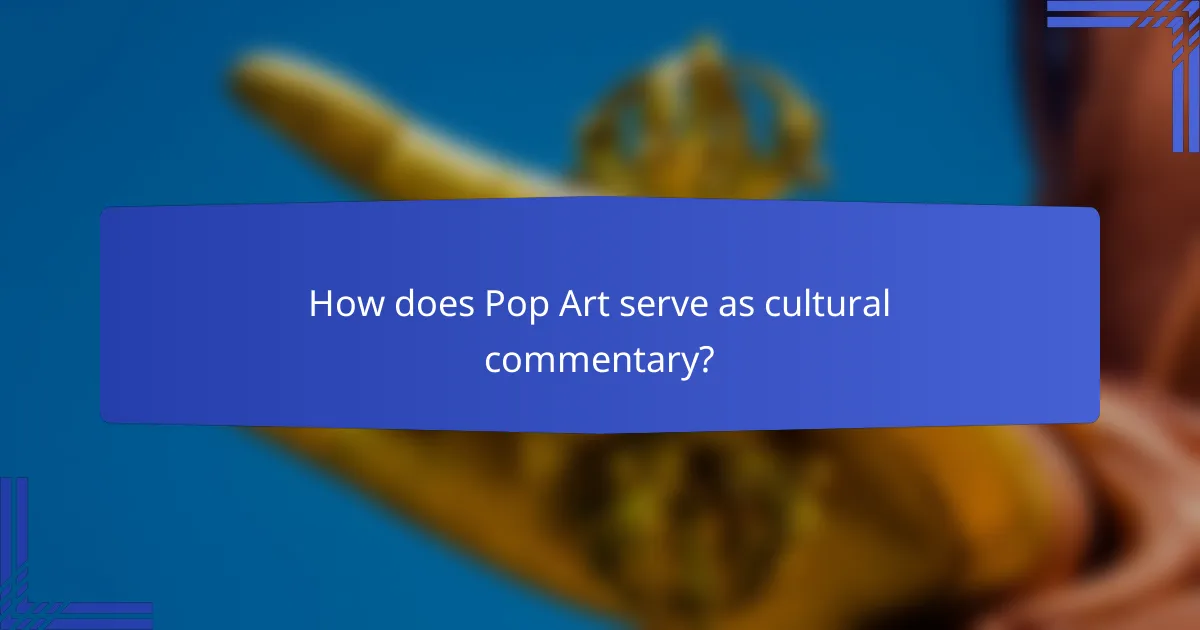Pop Art emerged as a powerful movement that both celebrated and critiqued consumerism, reflecting the profound impact of mass media on society. By blurring the boundaries between high art and commercial products, it offered a vibrant commentary on the consumer-driven culture of the mid-20th century. Through its bold imagery and incorporation of popular elements, Pop Art captured the essence of an era increasingly shaped by advertising and media saturation.

How did Pop Art influence consumerism in the UK?
Pop Art significantly shaped consumerism in the UK by celebrating and critiquing mass-produced goods and popular culture. This movement blurred the lines between high art and commercial products, reflecting the growing influence of advertising and media on everyday life.
Emphasis on mass production
Pop Art emerged during a time when mass production was becoming increasingly prevalent, particularly in the UK. Artists like Andy Warhol highlighted the repetitive nature of consumer goods, using techniques such as silkscreen printing to mimic industrial processes. This emphasis on mass production challenged traditional notions of originality in art.
By showcasing everyday items like soup cans and soda bottles, Pop Art encouraged viewers to reconsider their relationship with mass-produced products. It suggested that art could be found in the mundane, elevating consumer goods to the status of fine art.
Integration of commercial products
Pop Art artists often integrated commercial products into their work, using recognizable brands and logos to comment on consumer culture. For instance, works featuring Coca-Cola or Campbell’s Soup not only celebrated these products but also critiqued their omnipresence in society. This integration blurred the boundaries between art and advertising.
In the UK, this approach resonated with a population increasingly surrounded by commercial imagery. The use of familiar products in art made the works accessible and relatable, prompting discussions about the impact of consumerism on identity and culture.
Reflection of consumer culture
Pop Art served as a mirror to the consumer culture of the UK, reflecting the desires and anxieties of a society increasingly driven by consumption. The movement highlighted how media and advertising shaped public perception and consumer behavior. Artists used irony and humor to critique the superficiality of consumerism.
By portraying the glitz and glamour of consumer goods alongside their underlying emptiness, Pop Art encouraged viewers to question the values associated with materialism. This cultural commentary remains relevant today as society continues to grapple with the implications of consumer culture.

What role did media play in the rise of Pop Art?
Media played a crucial role in the rise of Pop Art by shaping public perception and consumer culture. The proliferation of television, advertising, and popular imagery influenced artists to reflect and critique the burgeoning consumerism and media saturation of the mid-20th century.
Television and advertising impact
Television and advertising significantly shaped the landscape of Pop Art by introducing new visual languages and themes. Artists like Andy Warhol utilized the aesthetics of commercial advertisements, transforming mundane products into high art. This crossover blurred the lines between art and commerce, making consumer goods a central focus of artistic expression.
Moreover, the rapid dissemination of images through television allowed artists to reach wider audiences, fostering a culture where visual consumption became a norm. The bright colors and bold graphics of advertisements inspired many Pop artists to adopt similar styles, creating a dialogue between art and the commercial world.
Use of popular imagery
Pop Art is characterized by its use of popular imagery drawn from mass media, comics, and everyday objects. Artists often appropriated images from magazines, cartoons, and product packaging, elevating these elements to the status of fine art. This approach challenged traditional notions of art by celebrating the mundane and the kitsch.
For instance, Roy Lichtenstein’s comic strip-inspired paintings highlighted the visual language of popular culture, while Warhol’s Campbell’s Soup Cans turned a familiar grocery item into an iconic artwork. This use of popular imagery not only reflected societal values but also critiqued the commercialization of culture.
Celebrity culture representation
Celebrity culture became a prominent theme in Pop Art, with artists exploring the fascination and obsession with fame. The depiction of celebrities in art served as both a celebration and a critique of the media’s role in shaping public personas. Warhol’s portraits of figures like Marilyn Monroe and Elvis Presley exemplified this trend, showcasing the allure and superficiality of celebrity status.
This representation often highlighted the transient nature of fame, as well as the impact of media on personal identity. By incorporating celebrity imagery, Pop artists commented on the commodification of individuals in a consumer-driven society, reflecting broader cultural dynamics at play during that era.

How does Pop Art serve as cultural commentary?
Pop Art serves as a cultural commentary by reflecting and critiquing the consumer-driven society of the mid-20th century. Through its vibrant imagery and incorporation of commercial elements, it highlights the relationship between art, media, and mass culture.
Critique of capitalism
Pop Art critiques capitalism by exposing the commodification of culture and the pervasive influence of advertising. Artists like Andy Warhol used everyday products and celebrities to challenge the notion of originality and value in art, suggesting that consumer goods hold as much significance as traditional artworks.
This critique often manifests through irony and humor, as artists juxtapose high art with low culture, prompting viewers to reconsider their consumption habits and the societal implications of capitalism.
Exploration of identity
Pop Art explores identity by reflecting the diverse experiences and perspectives within a consumerist society. Artists often incorporate elements of popular culture that resonate with various demographics, allowing for a dialogue about race, gender, and class.
For instance, works by artists like Roy Lichtenstein and Claes Oldenburg engage with stereotypes and cultural icons, prompting viewers to question how identity is shaped by media representations and consumer choices.
Social issues representation
Pop Art represents social issues by addressing contemporary themes such as war, inequality, and environmental concerns through a lens of popular culture. By using familiar imagery, artists can make complex issues more accessible and relatable to the public.
For example, works that incorporate imagery from protests or political events serve as a reminder of the societal challenges of the time, encouraging viewers to engage with these issues critically and thoughtfully.

What are the key characteristics of Pop Art?
Pop Art is characterized by its vibrant colors, incorporation of commercial techniques, and reflection of popular culture. This art movement emerged in the mid-20th century, challenging traditional boundaries between high art and everyday life.
Bright colors and bold imagery
One of the most striking features of Pop Art is its use of bright colors and bold imagery. Artists often employed vivid hues to grab attention and evoke emotions, making their work visually stimulating. This approach contrasts sharply with the muted tones typically found in earlier art movements.
For example, works by artists like Andy Warhol and Roy Lichtenstein showcase high-contrast colors and graphic designs that mimic advertising aesthetics. This choice of color not only enhances visual appeal but also emphasizes the commercial aspects of modern life.
Use of commercial techniques
Pop Art frequently utilizes commercial techniques, such as screen printing and collage, to blur the lines between fine art and mass production. These methods allow artists to reproduce images quickly and efficiently, reflecting the consumerist culture of the time.
By adopting techniques from advertising and packaging, Pop Art challenges the notion of originality in art. For instance, Warhol’s use of silkscreen printing enabled him to create multiple versions of the same image, highlighting the repetitive nature of consumer goods.
Incorporation of popular culture
Another defining characteristic of Pop Art is its incorporation of elements from popular culture, including celebrities, comic strips, and everyday objects. This focus on the familiar resonates with a broad audience, making art more accessible and relatable.
Artists like Lichtenstein drew inspiration from comic books, transforming mundane visuals into high art. By doing so, they not only celebrated popular culture but also critiqued its impact on society, prompting viewers to reflect on consumerism and media influence.

How did Pop Art evolve in the 20th century?
Pop Art emerged in the mid-20th century as a response to the rise of consumerism and mass media, blending fine art with popular culture. It challenged traditional boundaries by incorporating imagery from advertising, comic books, and everyday objects, reflecting societal changes and the influence of media on public perception.
Influence of Abstract Expressionism
Abstract Expressionism laid the groundwork for Pop Art by emphasizing individual expression and emotional intensity. While Abstract Expressionists focused on abstraction and personal experience, Pop Artists shifted their attention to the external world, using recognizable imagery to comment on consumer culture.
This transition marked a significant departure from the introspective nature of Abstract Expressionism, allowing artists to engage with the visual language of advertising and mass production. The vibrant colors and bold forms of Abstract Expressionism also influenced the aesthetic choices of Pop Artists.
Emergence of key artists
Key artists like Andy Warhol, Roy Lichtenstein, and Claes Oldenburg played pivotal roles in defining the Pop Art movement. Warhol’s use of silkscreen techniques to reproduce images of celebrities and consumer goods exemplified the merging of art with commercialism.
Lichtenstein’s comic strip-inspired works transformed everyday visuals into high art, while Oldenburg’s sculptures of ordinary objects challenged perceptions of scale and value. These artists not only popularized the movement but also sparked discussions about the nature of art and its relationship with society.
Global expansion of the movement
Pop Art quickly spread beyond the United States, influencing artists worldwide and adapting to various cultural contexts. In the UK, artists like Richard Hamilton and Peter Blake incorporated elements of British culture, creating a unique interpretation of the movement.
As Pop Art evolved globally, it began to reflect local consumer habits and media landscapes, leading to diverse expressions in countries such as Japan and Brazil. This global expansion highlighted the universal themes of consumerism and media influence, making Pop Art a significant cultural commentary across different societies.
